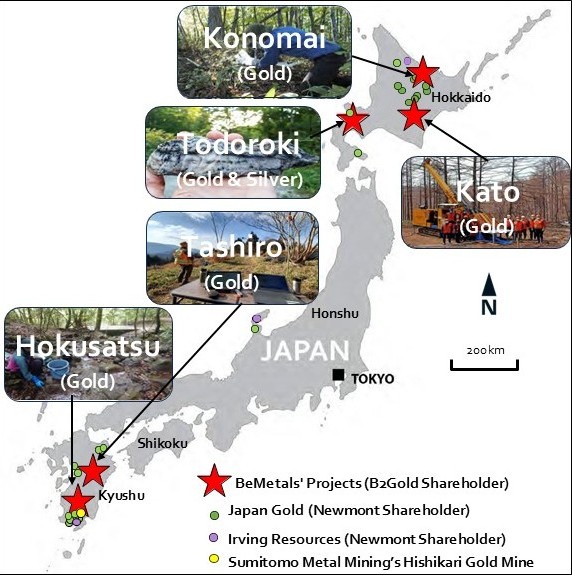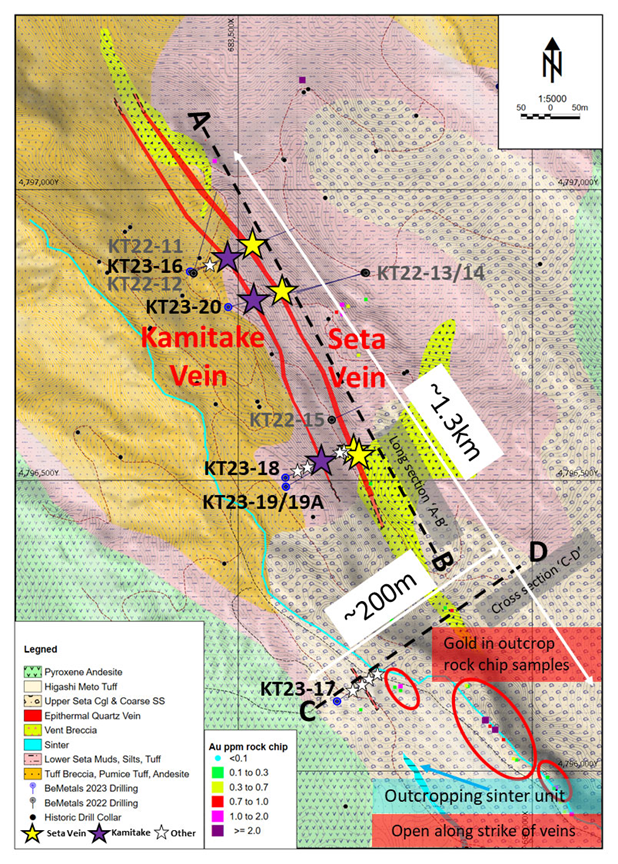Kazan Gold Project – Japan
Overview
The Kazan Gold Project is a portfolio of high-quality gold exploration properties located in Japan, representing a rare opportunity to explore in one of the world’s most technically advanced and politically stable mining jurisdictions.
The project portfolio includes several properties across Hokkaido and Kyushu, targeting low-sulphidation epithermal gold systems similar to those that host Japan’s most famous gold deposits, such as the Hishikari Mine (Sumitomo Metal Mining).
BeMetals’ strategy at Kazan is to advance and unlock value from this portfolio through partnerships and focused exploration, applying modern techniques to historic and underexplored mineral systems.
Option Agreement with Private Australian Exploration Company
In Q3 2025, BeMetals Corp. entered into an option agreement with a private Australian exploration company granting that group the right to earn a majority interest in the Kazan Gold Project portfolio.
Under the terms of the agreement, the Australian partner may earn up to a majority interest in the portfolio through staged cash, share, and exploration expenditure commitments. This partnership allows BeMetals to leverage external exploration capital and expertise while retaining exposure to discovery upside across multiple projects in Japan.
Project Portfolio & Location
The Kazan portfolio includes five key project areas across the islands of Hokkaido and Kyushu, each with distinctive geological features and exploration potential:
| Project | Region | Highlights |
|---|---|---|
| Kato | Hokkaido | Advanced-stage project with strong drill results from quartz–adularia veins. Historical intercepts include 17.5 m @ 8.15 g/t Au and 18.65 m @ 5.01 g/t Au. Recent BeMetals drilling intersected 11.5 m @ 6.42 g/t Au and 26.1 m @ 3.06 g/t Au in the Seta Vein. |
| Todoroki | Hokkaido | Early-stage project with multiple mineralized vein systems and historical workings. Surface samples up to 9.4 g/t Au and 650 g/t Ag. |
| Konomai | Hokkaido | Located near the historic Konomai Gold Mine district. Structural and geochemical anomalies suggest untested gold-bearing veins. |
| Tashiro | Kyushu | Hosts vein swarms and hydrothermal alteration zones. Preliminary work indicates potential for a large-scale epithermal system. |
| Hokusatsu | Kyushu | Situated near the high-grade Hishikari and Ohkuchi gold mines. Contains similar geological host rocks and alteration patterns. |
Geology & Mineralization
The Kazan portfolio targets low-sulphidation epithermal vein systems, characterized by quartz–adularia veins, breccias, and disseminated gold mineralization hosted in volcanic rocks.
These systems are formed by hydrothermal fluids ascending along faults and fractures, producing high-grade vein zones with excellent vertical continuity.
At Kato, mineralization occurs within a series of subparallel east–west trending veins, primarily the Seta Vein, which has been the focus of recent drilling.
- KT22-11: 11.5 m grading 6.42 g/t Au, including 4.52 m at 11.88 g/t Au.
- KT22-12: 26.1 m at 3.06 g/t Au, including 10.2 m at 4.88 g/t Au.
These results extend known mineralization along strike and confirm the potential for multiple stacked vein systems.
Infrastructure & Access
- Hokkaido projects (Kato, Todoroki, Konomai) benefit from excellent infrastructure — sealed road access, power availability, and proximity to established communities.
- Kyushu projects (Tashiro, Hokusatsu) are near historical mine workings and accessible year-round via well-developed transportation networks.
- Japan offers a stable regulatory environment, a skilled workforce, and modern infrastructure, supporting efficient exploration operations.
Next Steps
With the option agreement now in place, the Australian exploration partner will conduct targeted fieldwork and drilling to expand known mineralized zones at Kato and apply modern exploration methods to refine future drill targeting.
BeMetals will continue to support the partnership technically and strategically, while maintaining exposure to potential gold discoveries across the Kazan portfolio.
Why the Kazan Gold Project Matters
- Multiple discovery opportunities across five distinct projects in underexplored gold belts.
- Demonstrated high-grade results from Kato, confirming potential for significant epithermal systems.
- Japan’s modern infrastructure and mining heritage provide a strong foundation for exploration success.


